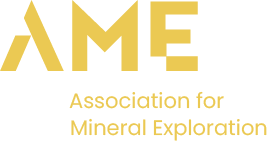Lorem ipsum dolor sit amet, consectetur adipiscing elit. Ut elit tellus, luctus nec ullamcorper mattis, pulvinar dapibus leo.
Acidic precipitation: Snow and rain with a low pH, caused by industrial atmospheric emissions.
Acidic rocks: Igneous rocks high in silica.
Acid mine drainage: Acidic runoff water from mine waste dumps and mill tailings.
Adit: A horizontal mine access.
Aerial magnetometer: Measures magnetic field strength from an airplane.
Aeromagnetic survey: A geophysical survey done using magnetometers on aircraft.
Agglomerate: A rock made of volcanic fragments.
Agglomeration: Concentrating minerals based on adhesion properties.
Agitation: In metallurgy, the act of stirring or shaking.
Airborne survey: A survey from an aircraft to obtain data.
Alloy: A compound of multiple metals.
Alluvium: Sedimentary deposits laid down in certain environments.
Alpha meter: Measures positively charged particles from radioactive materials.
Alpha ray: Positively charged particle from certain radioactive materials.
Alteration: Physical or chemical rock change post-formation.
Amorphous: Rocks or minerals without a definite crystal structure.
Amortization: Systematic writing off of account balances.
Amphibolite: A rock mostly made of amphibole and plagioclase.
ANFO: Blasting agent used in many mines.
Annual report: Yearly corporate financial and operational report.
Anode: A metal plate used in electrolytic refining.
Anomaly: Indication of mineralization in underlying bedrock.
Anthracite: A hard, black coal.
Anticline: An arch or fold in rock layers.
Apex: The top of a vein or its closest surface point.
Ash: Residue after coal ignition.
Assay: Chemical test to determine ore metal content.
Assessment work: Work needed to keep legal control of mining claims.
Authorized capital: Refers to capital stock.
Autogenous grinding: Ore grinding using large ore pieces.
Back: Ceiling or roof of an underground mine opening.
Backfill: Waste material filling the void after ore extraction.
Background: Minor radioactivity due to cosmic rays or residual radioactivity.
Ball mill: A cylinder filled with steel balls to crush ore.
Basalt: A dark volcanic rock.
Basement rocks: Older or underlying rock mass.
Base metal: Non-precious metals.
Batholith: A large igneous rock mass.
Bauxite: The main ore of aluminum.
Bear market: When share prices are decreasing.
Bedding: The layering of sedimentary rocks.
Beneficiate: To concentrate or enrich ores.
Bessemer: Low-phosphorus iron ore.
Biotite: A magnesium-iron mica.
Bit: Cutting end of a drill.
Blackjack: Another term for sphalerite.
Blaster: Person responsible for detonating blastholes.
Blast furnace: A vessel for chemical ore reduction.
Blister copper: Crude copper before refining.
Block caving: A mining method involving large ore blocks.
Bull market: When share prices are rising.
Bullion: Metal formed into bars.
Byproduct: Secondary product recovered in processing.
Cable bolt: A support in unstable ground.
Cage: Elevator used in a mine shaft.
Calcine: Concentrate ready for smelting.
Call: An option to buy shares.
Capitalization: Value markets put on a company.
Capital stock: Total ownership of a company.
Carbon-in-pulp: Gold recovery method.
Cash flow: Net inflow/outflow of cash during a period.
Cathode: Metal plate produced by electrolytic refining.
Cesium magnetometer: Geophysical instrument to measure magnetic fields.
Chalcocite: A copper sulphide mineral.
Chalcopyrite: Most important copper ore mineral.
Channel sample: Sample taken from a trench.
Chartered bank: A financial institution for deposits and loans.
Chromite: Chief ore mineral of chromium.
Chute: Opening for ore drawing in a stope.
Cinnabar: A red ore mineral of mercury.
Claim: A land portion held by a prospector or mining company.
Classifier: A mineral-processing machine for size and density.
Clay: Fine-grained material made of hydrous aluminum silicates.
Cleavage: A mineral’s tendency to split.
Closed circuit: Loop in the milling process.
Coal: A carbonaceous rock mined for fuel.
Collar: Timbering or concrete around a shaft mouth.
Decline: A downward underground opening, inclined from the horizontal.
Deduction: An amount deducted from the gross weight of ore for impurities.
Dewatering: The process of removing excess water.
Diamond drill: A drill that cuts by abrasion using embedded diamonds.
Dike: A rock formation that intrudes into a plane.
Dilution: The waste, which is mixed with ore in mining.
Dip: Angle of the beds or layers relative to the horizontal.
Disseminated: Small particles of ore mineral spread through rock.
Drag fold: The result of plastic deformation.
Drift: A horizontal or nearly horizontal underground passage.
Drill-indicated reserves: The amount of reserves calculated by measurements.
Dyke: A long and thick wall of rock, often igneous.
Electrolysis: Process to extract metals.
Electromagnetic survey: A geophysical survey using variations in the Earth’s electromagnetic field.
Elevated gold values: Gold values that are higher than the normal levels.
Epithermal deposit: A mineral deposit occurring near the Earth’s surface.
Exploration: Prospecting, sampling, mapping, diamond drilling to estimate ore reserves.
Exploitation: Extracting minerals from the Earth.
Extrusive: Igneous activity that occurs at the Earth’s surface.
Face: The end of a drift, crosscut, or stope where work is taking place.
Fault: A break in the Earth’s crust.
Feasibility study: A detailed study to determine the viability of a mining project.
Feldspar: A group of crystalline minerals.
Ferrous: Containing iron.
Flotation: A process used to separate mineral particles.
Flow-through shares: Shares in an exploration company.
Flux: A compound added to a smelted material.
Fold: A bend in rock layers.
Free milling: Ores that can be treated and the gold extracted by direct cyanide leaching.
Gabbro: A dark, coarse-grained igneous rock.
Galena: Lead sulfide, the most common ore mineral of lead.
Gangue: The waste minerals in an ore deposit.
Geiger counter: An instrument used to measure the radioactivity.
Geochemistry: The study of the chemical properties and processes of Earth.
Geology: The science of studying the Earth’s structure.
Geophysics: The study of the physical properties of the Earth.
Geothermal energy: Energy derived from the Earth’s internal heat.
Gneiss: A layered or banded crystalline rock.
Gold loan: A form of debt financing for gold mining companies.
Graben: A block of the Earth’s crust that has dropped relative to surrounding blocks.
Gravity meter: An instrument to measure the gravitational field of the Earth.
Gyratory crusher: A machine that crushes ore by an eccentrically gyrating spindle.
Haulage: The transport of mined material.
Head grade: The average grade of ore fed into a mill.
Heap leaching: A process to extract precious metals from ore by placing the crushed ore on a pad in a heap.
Hematite: An oxide of iron, and one of the most common ore minerals.
High-grader: A worker who steals high-grade ore.
Hydrothermal: Relating to hot fluids circulating in the Earth’s crust.
Igneous: Rocks that solidified from a molten state.
Ilmenite: An ore mineral of titanium.
Induced polarization: A method to measure the resistivity of the Earth.
Inferior grade: Relatively low-grade ores.
In situ: In the natural or original position.
Intrusion: A body of igneous rock that has forced its way into pre-existing rocks.
Jaw crusher: A machine to break rock between two steel jaws.
Jig: A machine to concentrate ore by the pulsation of water.
Joint: A fracture dividing rock into two blocks without any offset.
Kimberlite: A volcanic rock, potentially diamond-bearing.
Kyanite: A metamorphic mineral used to make porcelain.
Lagging: Planks or small timbers placed between steel ribs along mine walls.
Lateral: A horizontal underground passage.
Launder: A chute or trough for conveying pulp or ore.
Lava: Molten rock that comes out of a volcano.
Leaching: A chemical process by which a solute is extracted into a solvent.
Magma: Molten rock beneath the Earth’s surface.
Magnetite: An oxide of iron and an important ore of iron.
Manway: A drift used exclusively for the movement of personnel.
Matrix: The fine-grained mass of material in which larger grains, crystals, or minerals are embedded.
Metallurgy: The science and study of the behaviors and properties of metals and their extraction from their ores.
Metamorphism: The change or alteration in a rock caused by external conditions.
Mill: A plant where ore is processed and treated.
Mineral: A naturally occurring homogeneous substance with a definite chemical composition.
Mineralization: The deposition of metals in rock from hydrothermal fluids.
Muck: Loose material in mines, often referring to ore or waste.
Nugget: A small mass of precious metal, usually gold, found free in nature.
Native metal: A metal found in nature in its pure state, not combined with other elements.
Ore: A naturally occurring material that can be profitably mined.
Ore body: An aggregation of ore with sufficient concentration to make mining economically viable.
Outcrop: That part of a geologic formation or structure that appears at the surface of the Earth.
Overburden: Layers of soil and rock covering a coal or ore deposit.
Panning: The simplest method of separating gold from placer material.
Pegmatite: A coarse-grained igneous rock.
Permeability: The ability of a rock or soil to transmit water or other fluids.
Placer: A deposit of sand and gravel containing valuable metals.
Porphyry: A rock texture of relatively large crystals set in a finer-grained matrix.
Quarry: A place where rock or minerals are extracted from the surface.
Quartz: A mineral composed of silicon dioxide.
Reclamation: The restoration of a site after mining or exploration activity is completed.
Refractory ore: Ore that resists the action of chemical reagents in the normal treatment processes.
Reserves: The amount of ore in a deposit that can be economically mined.
Riffle: Bars, slats, or obstructions placed in a sluicing system to capture gold particles.
Sampling: Taking small pieces of rock from a deposit to determine its value.
Seam: A layer of ore or coal.
Shaft: A vertical or inclined excavation in rock for the purpose of providing access to an ore body.
Slag: The vitreous mass left as a residue by the smelting of metallic ore.
Stope: An excavation made in a mine to extract ore.
Tailings: Materials left over after the process of separating the valuable fraction from the ore.
Tunnel: An underground or underwater passage.
Uraninite: A radioactive, black, and gray mineral, an important ore of uranium.
Vein: A fissure or crack in rock filled by minerals.
Volcanic: Pertaining to the activities, structures, or rock types of volcanoes.
Waste: Unmineralized, or sometimes mineralized, rock that is not mined for a profit.
Winze: An internal shaft, or a hole sunk from a shaft or adit.
Xenolith: A fragment of country rock found in an intrusive igneous body.
Yield: The quantity of ore or metal produced in a specified period.
Zinc: A metallic element used primarily in alloys.
Zone: An area of rock with distinct physical characteristics or mineral content.




